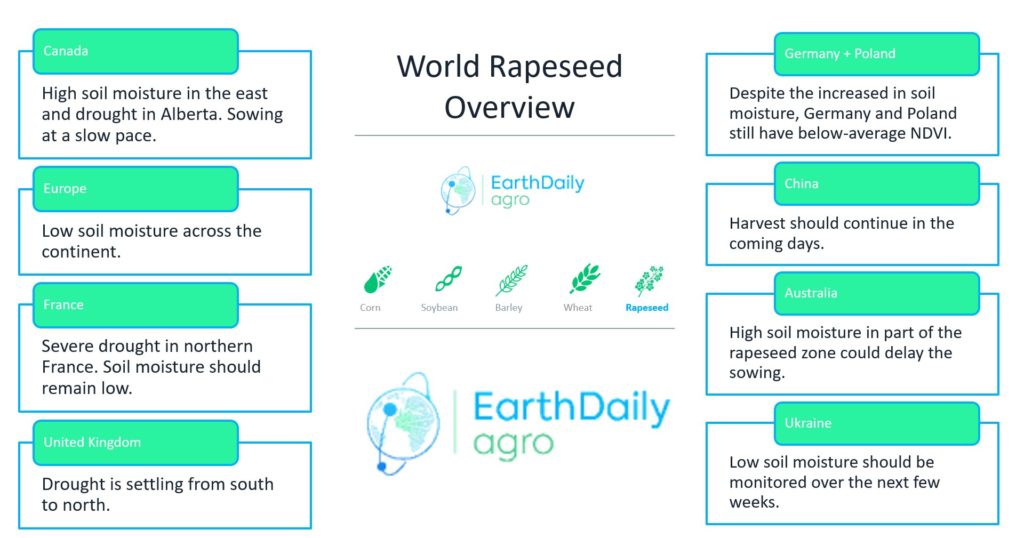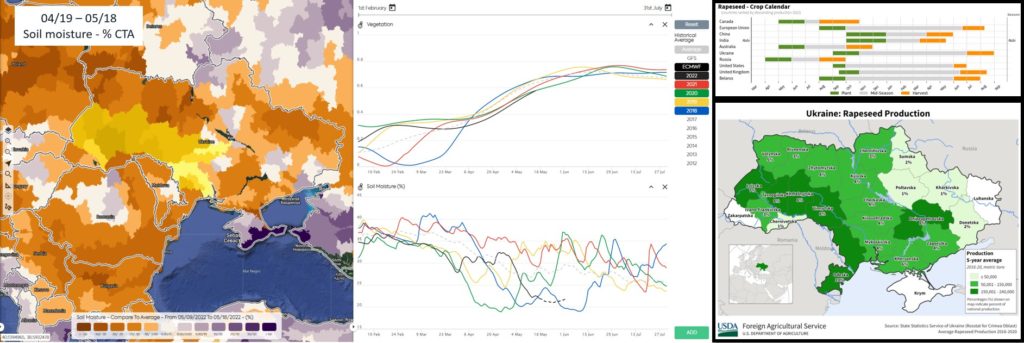
Global rapeseed supply: European countries relying on Ukraine may need to look to other top producers
Highlights of crop conditions in key rapeseed-buying countries based on EarthDaily Agro reports.
Several European nations rely on Ukraine for their rapeseed needs. With production threatened in Ukraine, countries such as Belgium, Germany, Netherlands, U.K. and Poland may need to look to other top rapeseed producers to meet their domestic needs. Across the Black Sea, Turkey is also highly dependent on Ukrainian rapeseed.
Rapeseed supply is of concern in these countries, not only due to conditions in Ukraine but also to domestic growing concerns. Cultivated mainly for its oil-rich seed, rapeseed is the third largest source of vegetable oil and the second largest source of protein meal in the world.
Current vegetation indices in Ukraine show low soil moisture in the rapeseed-growing zone, which is primarily central to western Ukraine. Lower-than-normal temperatures may also affect planting season. The war in Ukraine may also affect production, processing and distribution.
To meet domestic demand, the U.K. relies on Ukraine for 50 percent of its rapeseed; Belgium imports 30 percent from Ukraine. Turkey imports 70 percent of its domestic need from Ukraine.
Although several European countries grow their own rapeseed, they don’t produce enough of it to meet domestic demand, much less offset the reduced supply from Ukraine. Germany, the U.K. and Poland grow their own rapeseed, but drought is threatening growing conditions across northern Europe.
The Netherlands has comparably low rapeseed supply and must import most of their needs.
France offsets its domestic production with rapeseed from Canada; global demand may threaten that supply.
Turkey is recovering from severe drought, and soil moisture has gradually increased. Rapeseed planting is expected to begin in August, with harvest in November. In the event of a crop failure, Turkey may struggle to meet domestic demand.
Rapeseed conditions in other major-producing countries
If these countries are unable to meet their domestic demands, either from Ukraine production or their own growing, they will look to other global producers: Canada, Australia, and China. Rapeseed growing conditions vary across these countries.
In Canada, planting is currently at a slow pace due to high soil moisture in the east and drought in the west. Seeding in Alberta is 64 percent compared to 82.4 percent averaged over the past ten years. Saskatchewan and Manitoba are also behind in planting, although below-average precipitation in the east will help to reduce soil moisture, favorable for the sowing.
In Australia, conditions are good for the start of the rapeseed cycle. In China, the rapeseed harvest is almost complete, and yields are anticipated to be normal.
European countries looking to offset their rapeseed needs from Ukraine may look to Canada, Australia and China to meet their domestic needs. The question is whether the countries will be able to make up for the lack of rapeseed coming from Ukraine and meeting global demand. And at what price.
New data on global rapeseed supply and demand
EarthDaily Analytics and its EarthDaily Agro agriculture division are harnessing the power of Earth Observation technology to actively monitor crop health around the world. Through this monitoring, EarthDaily is able to detect early warning signs of production distress, equipping food security agencies and organizations to take proactive action.
Under this initiative, EarthDaily is creating a series of crop monitoring reports. Each report focuses on a different crop and its health across major producing countries as well as potential impacts to dependent importing countries. The initial report for wheat was released March 31, and a follow-up alert released May 11. Subsequent reports have also been released for corn (April 15) and barley (May 5).
Today, EarthDaily has released the next report in the series to provide the latest production update for rapeseed.
Access the updated rapeseed reports now
EarthDaily Analytics and its EarthDaily Agro agriculture division are harnessing the power of Earth Observation technology to actively monitor crop health around the world. Through this monitoring, EarthDaily is able to detect early warning signs of production distress, equipping food security organizations to take proactive action.
Learn more about the initiative at www.earthdailyagro.com/ukraine. For more information, contact our analysts, who can provide daily crop monitoring, weather forecasting and production estimation of crop-producing regions worldwide.



